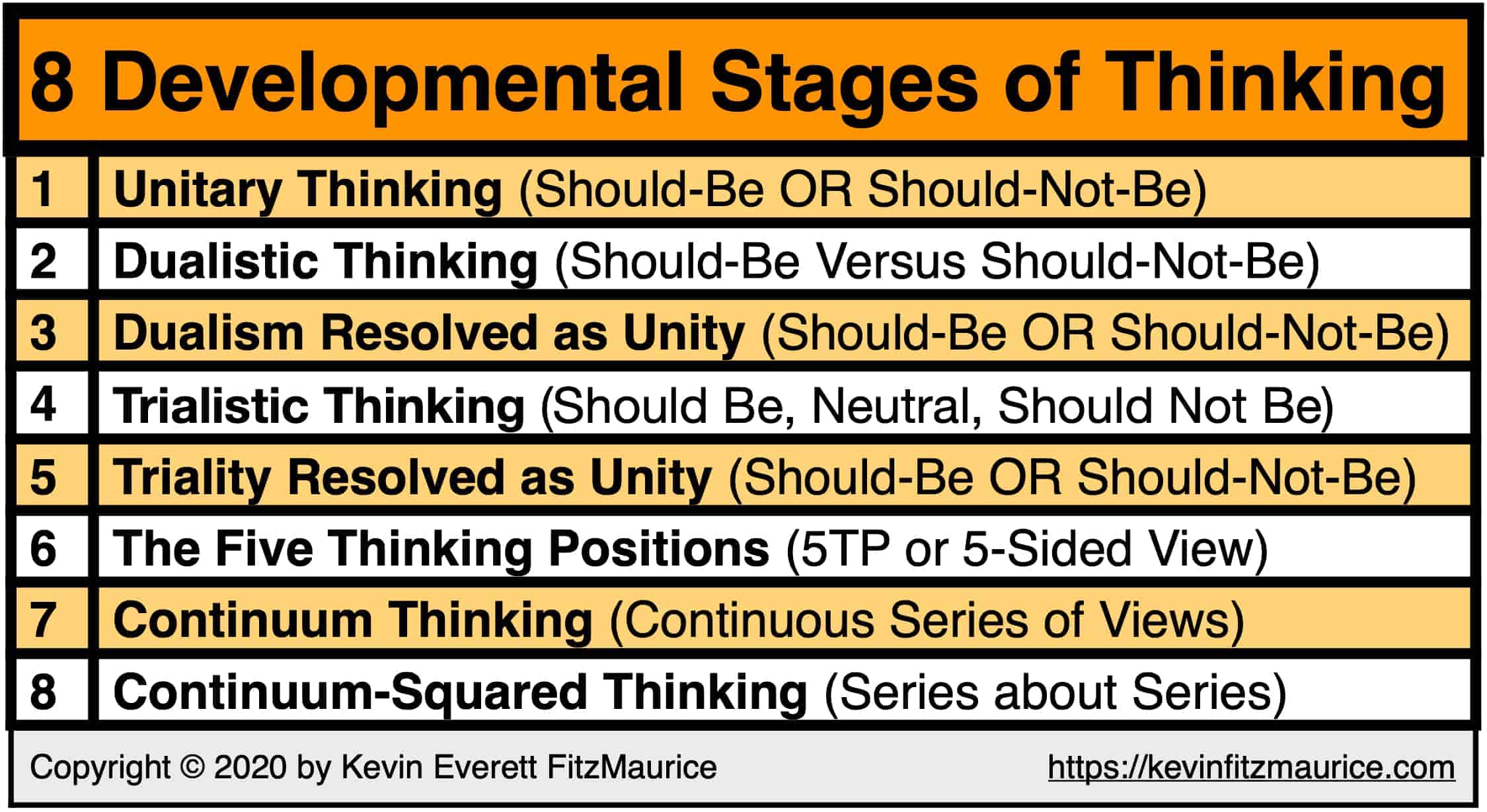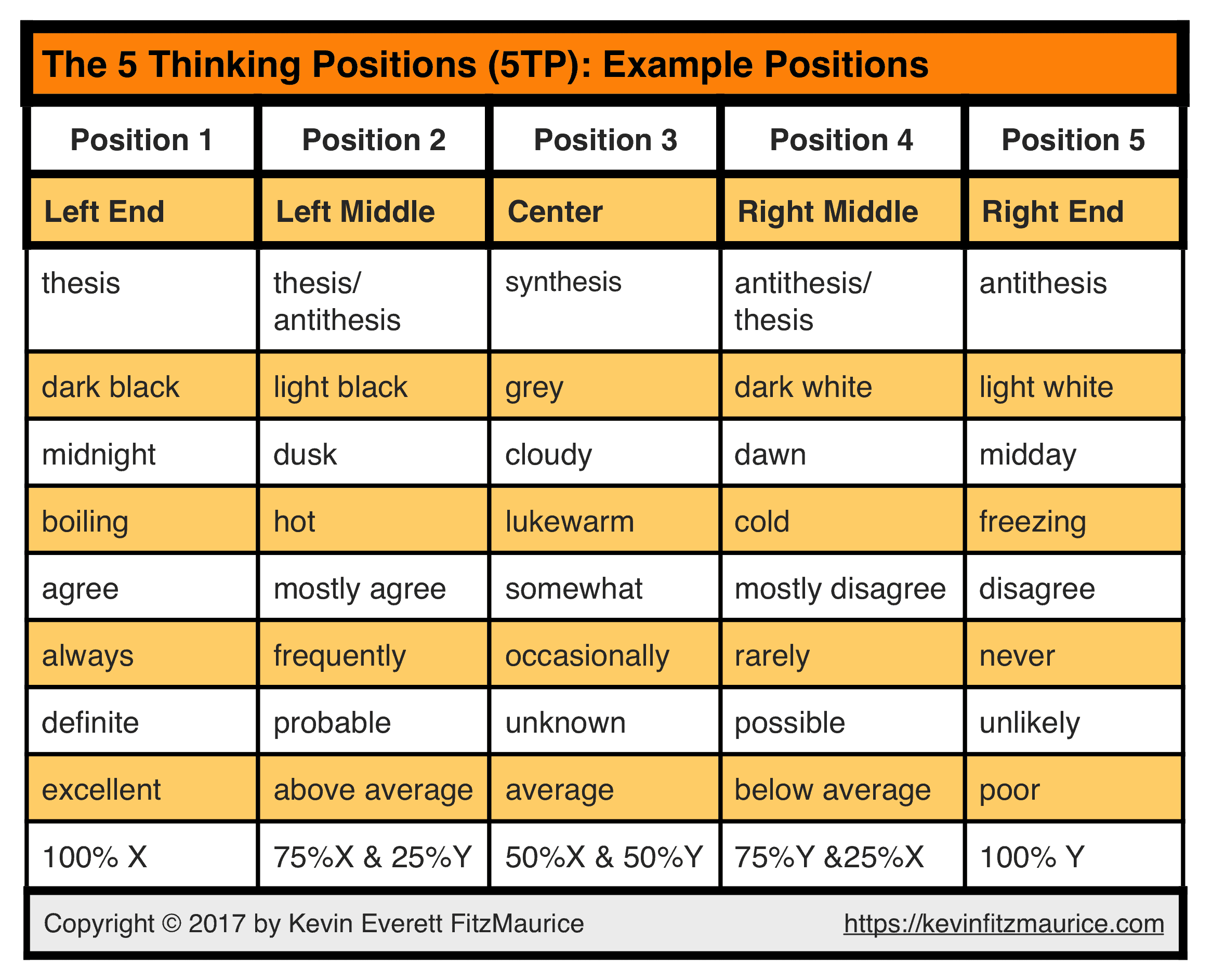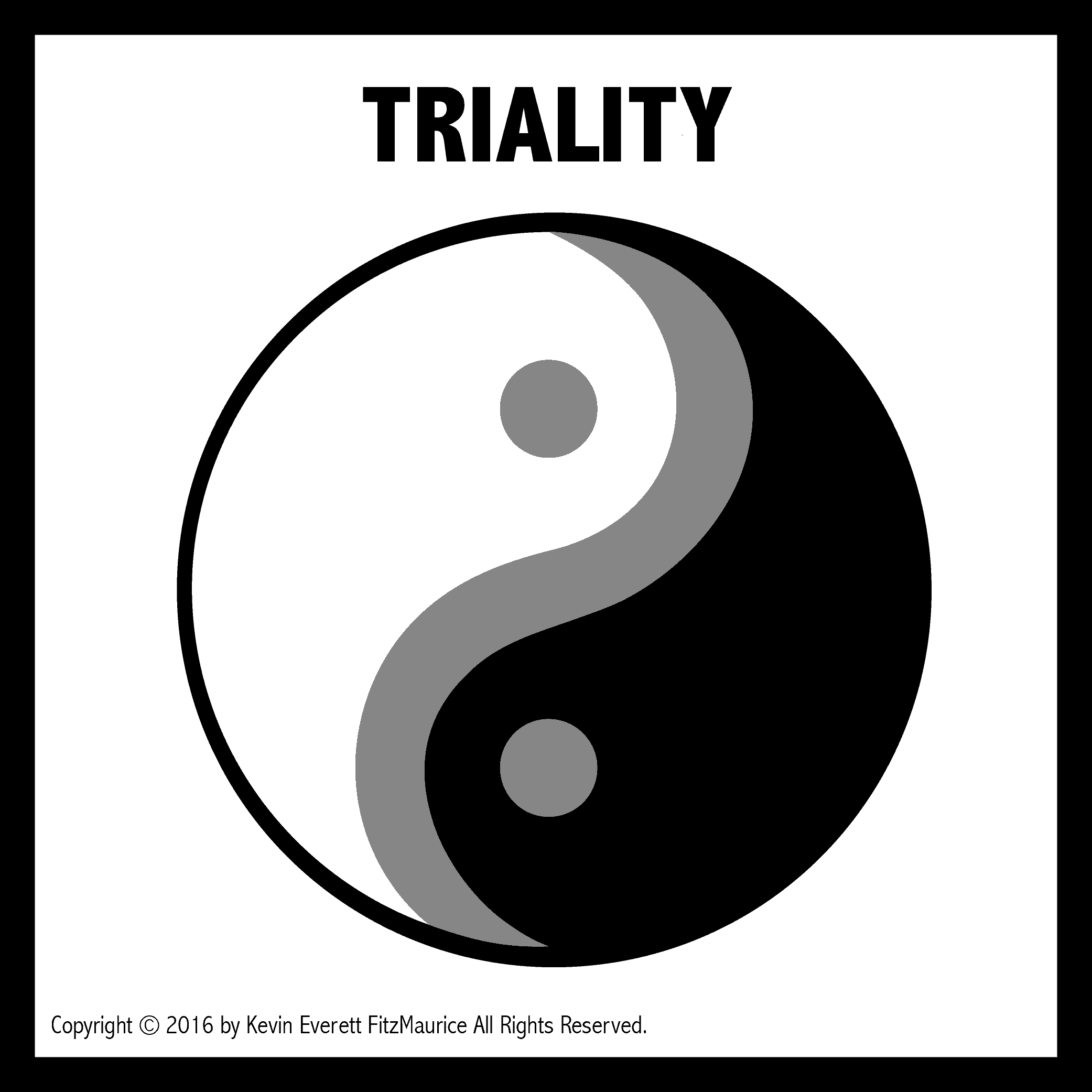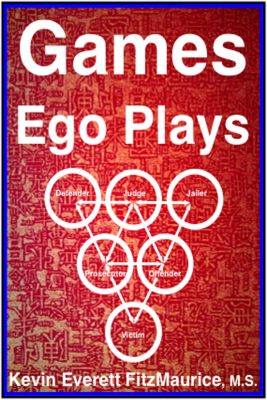Thinking8 StagesInformation on 8Table of 8Evolution of Perspective5 Thinking PositionsTrialityRelated Pages6 Groups of Topics9 Skills & Topics
Development of Thinking: 8 Stages
- We’re All Insane! Second Edition will teach you how to think better and saner.
- Discover Games Ego Plays to learn more about the 5TP.
- Discovery Demands 5TP: The Evolution of Perspective
Development of Thinking: Here are the eight stages for developing superior thinking that you can practice today.
“Nothing is at last sacred but the integrity of your own mind.” —Ralph Waldo Emerson
“Let reason go before every enterprise, and counsel before every action.” —Ecclesiasticus 38:33
“There are five sides to every story.” —Kevin Everett FitzMaurice
- Read to Understand Higher Levels of Thinking
- Understand the development of thinking now.
Development of Thinking: 8 Levels
1. Unitary Thinking
2. Dualistic Thinking
3. Dualism Resolved into a New Unity
4. Trialistic Thinking
5. Triality Resolved into a New Unity
6. 5TP (The Five Thinking Positions)
7. Continuum Thinking
8. Continuum-Squared Thinking
- Read to Understand Higher Levels of Thinking
- Understand the development of thinking now.
Development of Thinking
Information on the 8 Levels
Thinking Can Develop But Does Not Have To
- People develop to a level and typically stay there.
- Some people never develop past the first level.
1. Unitary Thinking (Should-Be OR Should-Not-Be)
- Unitary or basic thinking is having one idea, perspective, position, or view about one subject or topic.
- Unitary thinking incorporates and links similar ideas and experiences into its perspective.
- Unitary thinking collects evidence favoring its position while ignoring or discounting evidence against it.
- Unitary thinking provides security by providing one answer.
- Unitary thinking ends conflict, pressure, and stress by providing one answer.
- Unitary thinking provides pride by providing one answer that is regarded as superior to all other answers.
- Unitary thinking can be understood as a fundamental drive of human nature. For example, believing that all things are one satisfies all primitive demands for security and pride by providing a superb unitary idea that is regarded as unassailable.
- Unitary leads to duality because every should-be has its should-not-be. Eventually, a unitary thinker will stumble upon the should-not-be for their should-be.
- Examples of simple should-bes: get food, get water, get clothing, get shelter, get weapons.
- Examples of simple should-not-be: kill a threatening animal, get out of the river before you drown, and escape a dangerous predator.
2. Dualistic Thinking (Should-Be Versus Should-Not-Be)
- Dualism incorporates unitary thinking.
- Dualism is thinking of two opposite or competing ideas about one subject or topic.
- Dualism can be understood as having two competing unitary positions simultaneously.
- Dualism can be understood as awareness that Unitary thinking has two sides, even if one is hidden.
- Dualism is characterized by anxiety, conflict, pressure, strain, stress, and struggle.
- The basic dualism is “they should be” versus “they should not be.”
3. Dualism Resolved into a New Unity (Should-Be OR Should-Not-Be)
- A dualism is resolved into one idea or one side of the duality.
- For example, you choose to be pro-abortion or anti-abortion while denying the validity of the existence of the opposite position. This often leads to emotional violence to try to end the competing position.
- Dualism can also be proactively used to produce a creative solution to its conflict. However, this typically leads to a new dualism, as was pointed out by Hegel.
4. Trialistic Thinking (Should Be, Neutral, Should Not Be)
- Triality incorporates duality and adds a third section in-between them.
- Triality adds neutrality, which changes everything, as did the addition of zero to mathematics.
- Triality is thinking that two basic opposite ideas with a range of ideas existing in between them straddle a neutral midpoint.
- Triality is a useful starting point when forming a strong composite, fusion, or synthesis.
- Triality is the beginning of gaining the skill of perspective-taking (viewing all sides of an issue).
- Triality allows observing a dualistic battle by stepping into the neutral space (detached, disinterested, meditator, mindfulness, objective, observer, recorder, uninvolved, witness).
5. Triality Resolved into a New Unity (Should-Be OR Should-Not-Be)
- A triality is resolved into one idea such that the other positions are either annihilated, subsumed, or condensed into one.
- For example, you believe there are many transportation options but choose one method above all competing methods for the solution for your city. The options existed on various continuums such as cost, feasibility, environmental impact, citizen acceptance, etc.
- The resolution of a triality into a unity can be productive or not, depending on the circumstances and issues involved.
6. The Five Thinking Positions (5TP or 5-Sided View)
- 5TP incorporates triality and includes two more variables in-between each endpoint and the middle of the triality.
- 5TP thinks there are always five basic viewpoints on any subject or topic.
- Acceptance and open-mindedness characterize 5TP thinking.
- 5TP is the act of perspective-taking and represents the progress of Western thinking.
- 5TP thinking often prefers one or more positions over the others; however, this does not necessarily lead to a unitary position as typically happens with duality and triality. Why? Because a preference does not deny other options.
7. Continuum Thinking
- Continuum thinking incorporates both triality and the 5TP.
- Continuum thinking is the idea that all subjects or topics exist on a continuum of positions that is generally infinite but that can be cut down to a manageable size by adding case examples or actualities.
- Continuum thinking is characterized by peace and unconditional acceptance.
- Continuum thinking is even less likely to lead to unitary positions than is the 5TP.
- Continuum thinking has a neutral midpoint and then extends points in opposite directions, for example, negative, neutral, and positive.
8. Continuum-Squared Thinking
- Continuum-squared thinking incorporates continuum thinking.
- Continuum-squared thinking can be understood as the process of reasoning or analysis.
- Continuum-squared thinking is the idea that all continuums have the potential for at least some variables (spaces, placeholders) on the continuum to become their continuum about the parenting continuum.
- Continuum-squared thinking can be visualized by thinking of the design of a crossword puzzle and imagining each word in the puzzle representing one continuum related to the main continuum.
- Not all the spaces or placeholders on the crossword puzzle are meant to be developed into a continuum.
- While developing all the markers (spaces, placeholders, variables) into their continuum is theoretically possible, it is impractical, unnecessary, and forced when applied to real-life situations.
- Another visualization you might prefer for continuum-squared thinking is that of a developed and well-played game of Scrabble.
- This is how chess masters think and plan while playing chess.
- In time, visual maps will be produced of continuum-squared thinking to represent developed reasons, problem-solving, and other activities that will facilitate their application to other issues and problems.
- Read to Understand Higher Levels of Thinking
- Understand the development of thinking now.
Development of Thinking
Table: 8 Thinking Skills
- Click for a diagram of triality.
- Read to Understand Higher Levels of Thinking
- Understand the development of thinking now.
Development of Thinking
The Evolution of Perspective
- Yes, Continuum Thinking could be a fifth level of development (in another table); however, perspective-taking works well at the 5TP level for most people.
Development of Thinking
5 Stage Evolution of Perspective
- Read to master the 5TP and perspective-taking.
Development of Thinking
The Five Thinking Positions (5TP)
- There are five sides to every issue, opinion, and story.
- Ready to master the 5TP and perspective-taking?
Development of Thinking
Triality: Move Beyond Duality
- Duality is a delusion because every duality must have a middle ground or neutral side.
- Read to understand the necessity of triality.
- Understand the development of thinking now.
Development of Thinking
Related Pages of Free Information
- 5TP: List Pages
- CBT, CT, & REBT Cognitive Psychotherapies: List Pages
- Constructivism: Pros & Cons
- Continuum Knowledge/Thinking
- Coping Skills: Free Help
- Counseling Issues: Free Help
- Ego & Self-Esteem Fast-Facts
- Emotional Responsibility: List Pages
- Exercises & Techniques: List Pages
- Feeling & Coping: Fast-Facts
- Meditation: List Pages
- Postmodern Foolishness
- Postmodernism & Constructivism Exposed
- Postmodernism & Ken Wilber’s Integral Model
- Quotations: Constructivism & Postmodernism
- REBT (Rational Emotive Behavior Therapy): List Pages
- Self-Esteem Issues: List Pages
- Thinking Skills: Free Help
- Triality: Move Beyond Duality
- Unconditional Self-Esteem (USE): Defined
- Read and discover the best diagrams and maps of how people play games with your mind and heart.
- Read and discover how CBT, REBT, & Stoicism evolved into one system: STPHFR.
- Read to Understand Higher Levels of Thinking
- Understand the development of thinking now.
Development of Thinking
6 Groups of Topics Menu
- 1. Pages by Topic
- 2. Fast-Facts by Topic
- 3. Quotations by Topic
- 4. Poems by Topic
- 5. Scripture by Topic
- 6. Websites by Topic
- Read and discover how CBT, REBT, & Stoicism evolved into one system: STPHFR.
- Read and discover the world’s best breathing exercise for centering and peace of mind.
- Read to Understand Higher Levels of Thinking
- Understand the development of thinking now.
Development of Thinking
9 Skills & Topics Menu
- 1. Anger Skills & Topics
- 2. Blame Skills & Topics
- 3. Communication Skills & Topics
- 4. Coping Skills & Topics
- 5. Counseling Skills & Topics
- 6. Praying Skills & Topics
- 7. Recovery Skills & Topics
- 8. Responsibility Skills & Topics
- 9. Thinking Skills & Topics
- Read and discover how CBT, REBT, & Stoicism evolved into one system: STPHFR.
- Read and discover the world’s best breathing exercise for centering and peace of mind.
- Read to Understand Higher Levels of Thinking
- Understand the development of thinking now.









